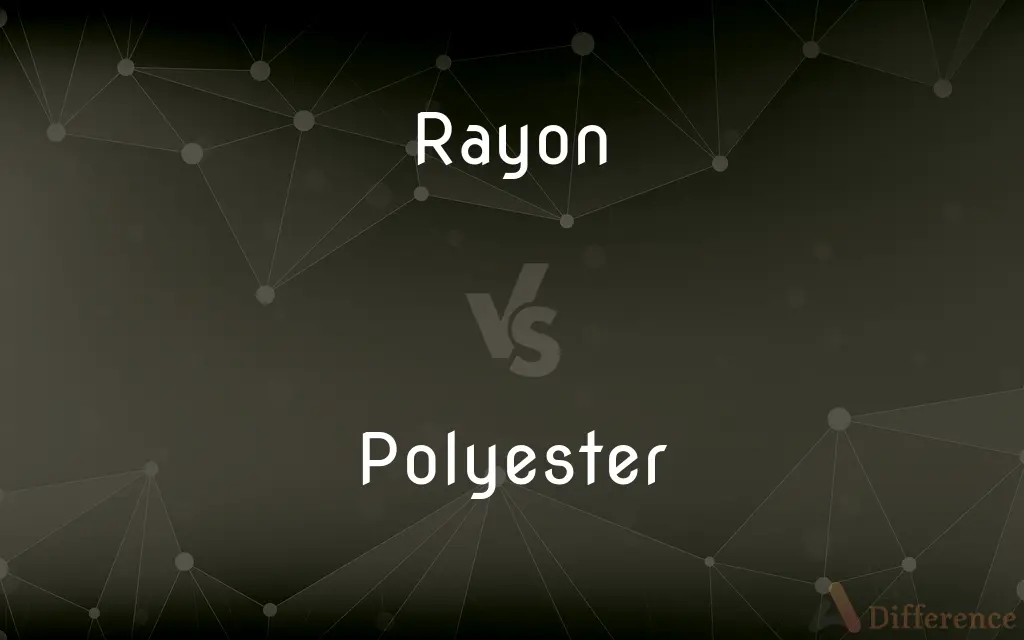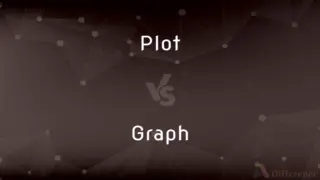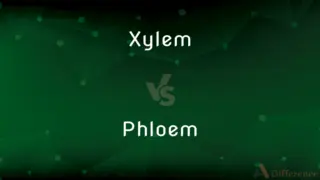Rayon vs. Polyester — What's the Difference?
Edited by Tayyaba Rehman — By Urooj Arif — Updated on April 18, 2024
Rayon is a semi-synthetic fiber derived from cellulose, known for its silk-like feel and moisture-absorbing properties, while polyester is a fully synthetic fiber, prized for its durability, resistance to shrinking and wrinkling.

Difference Between Rayon and Polyester
Table of Contents
ADVERTISEMENT
Key Differences
Rayon, originating from natural cellulose, often wood pulp, undergoes extensive processing to become a fiber that mimics natural textiles like cotton and silk in feel and drape. In contrast, polyester is crafted from petroleum-based chemicals, resulting in a fabric that is highly resistant to environmental conditions including moisture, making it extremely durable.
The manufacturing process of rayon involves the dissolution of cellulose and regenerating it into fibers, which makes it environmentally more taxing due to the chemicals used. Polyester, on the other hand, is synthesized through a chemical reaction involving coal, petroleum, air, and water, often considered less eco-friendly due to its non-biodegradable nature.
Rayon is breathable and comfortable against the skin, making it a popular choice for clothing intended to be worn in warm climates. Polyester, while less breathable, excels in insulation and is often used in fabrics for athletic wear and outdoor clothing because it wicks moisture away from the skin.
In terms of care, rayon can be more delicate, often requiring hand washing or dry cleaning to maintain its structure and appearance. Polyester is much easier to care for, as it is machine washable and resistant to shrinking and stretching, making it ideal for everyday and heavy-use garments.
While rayon offers a more natural aesthetic and comfort, it lacks the durability and easy maintenance of polyester, which remains a staple in the world of affordable and hard-wearing fabrics.
ADVERTISEMENT
Comparison Chart
Origin
Semi-synthetic (cellulose-based)
Fully synthetic (petroleum-based)
Feel
Soft, silk-like
Slightly rougher, plastic-like
Breathability
High
Low
Durability
Less durable, prone to tearing
Highly durable, resistant to tearing
Care
Requires delicate handling
Easy to care for, machine washable
Environmental Impact
Chemically intensive, biodegradable
Non-biodegradable, energy-intensive
Common Uses
Fashion garments, luxury wear
Athletic wear, outdoor clothing, everyday use
Compare with Definitions
Rayon
Absorbs moisture, making it pleasant to wear in hot weather.
He prefers wearing rayon shirts in the summer to help stay cool.
Polyester
Can be recycled to reduce environmental impact.
Recycled polyester is used to create eco-friendly clothing and accessories.
Rayon
Requires careful laundering to avoid damage.
She hand washes her rayon blouse to preserve its silky texture.
Polyester
A durable synthetic fabric used widely in clothing.
Polyester is often used for children's clothes due to its durability and stain resistance.
Rayon
A soft, versatile fabric made from regenerated cellulose.
The designer used rayon for the summer dresses because of its cool, comfortable texture.
Polyester
Resists wrinkles and shrinking, ideal for everyday wear.
His polyester pants are perfect for travel because they don't wrinkle.
Rayon
Used in a variety of clothing, including dresses and blouses.
Rayon is favored for use in flowing dresses and formal wear due to its elegant appearance.
Polyester
Non-absorbent, making it quick drying.
The team's soccer jerseys are made of polyester, which keeps the players dry.
Rayon
Known for its excellent drape and vibrant colors.
Rayon scarves are popular due to their bright colors and soft feel.
Polyester
Often blended with other fibers to enhance functionality.
Blending polyester with cotton improves the strength and longevity of the fabric.
Rayon
Rayon is a synthetic fiber, made from natural sources of regenerated cellulose, such as wood and related agricultural products. It has the same molecular structure as cellulose.
Polyester
Polyester is a category of polymers that contain the ester functional group in every repeat unit of their main chain. As a specific material, it most commonly refers to a type called polyethylene terephthalate (PET).
Rayon
Any of several synthetic textile fibers produced by forcing a cellulose solution through fine spinnerets and solidifying the resulting filaments.
Polyester
A synthetic resin in which the polymer units are linked by ester groups, used chiefly to make synthetic textile fibres.
Rayon
A fabric so woven or knit.
Polyester
Any of numerous synthetic polymers produced chiefly by reaction of dicarboxylic acids with dihydric alcohols and used primarily as light, strong, weather-resistant resins in boat hulls, textile fibers, adhesives, and molded parts.
Rayon
A manufactured regenerated cellulosic fiber.
Polyester
A wrinkle-resistant fabric of fibers made from any of these resins.
Rayon
Ray; beam.
Polyester
Any polymer whose monomers are linked together by ester bonds
Rayon
A synthetic fiber, made of thin filaments of regenerated cellulose, extruded from a solution of viscose. Called also viscose fiber and viscose rayon fiber.
Polyester
A material or fabric made from polyester polymer
Rayon
A textile fabric made from rayon{1}.
Polyester
Of, or consisting of polyesters
Rayon
A synthetic silklike fabric
Polyester
Any of numerous synthetic resins; they are light and strong and weather resistant
Polyester
A complex ester used for making fibers or resins or plastics or as a plasticizer
Polyester
Any of a large class of synthetic fabrics
Common Curiosities
Which fabric is better for the environment?
Both fabrics have environmental drawbacks, but polyester's ability to be recycled may offer some sustainability benefits over rayon's chemical-intensive production process.
How do rayon and polyester differ in care and maintenance?
Rayon generally requires more delicate care, often needing hand washing and avoiding high heat, while polyester is low-maintenance, machine washable, and resistant to shrinking and wrinkling.
Is rayon suitable for outdoor garments?
While rayon is comfortable and breathable, it's less durable and weather-resistant compared to polyester, making it less suitable for harsh outdoor conditions.
How do the costs of rayon and polyester compare?
Polyester is generally cheaper to produce and purchase than rayon, making it more prevalent in low-cost textiles.
What are some common misconceptions about rayon and polyester?
A common misconception about rayon is that it's a completely natural fiber, while many believe polyester feels uncomfortable and cheap, though modern polyester fabrics can be quite soft and pleasant.
What is the main difference between rayon and polyester?
Rayon is a semi-synthetic, cellulose-based fabric known for its softness and breathability, whereas polyester is a fully synthetic, petroleum-based fabric known for its durability and moisture resistance.
Can rayon and polyester be recycled?
Polyester is more commonly recycled than rayon, which often involves chemical processes that can complicate recycling efforts.
Why might someone choose polyester over rayon?
Due to its durability, ease of care, and resistance to environmental conditions, making it suitable for everyday and active wear.
Which fabric is better for athletic wear?
Polyester is generally better for athletic wear due to its durability, quick-drying properties, and moisture-wicking capabilities.
What are the typical uses for rayon in textiles?
Rayon is often used in fashion garments like dresses, blouses, and scarves due to its softness and drape.
Can both fabrics be used for home furnishings?
Yes, both rayon and polyester are used in home furnishings, but polyester is often favored for items that require durability and easy maintenance, such as curtains and upholstery.
How do rayon and polyester impact thermal comfort?
Rayon tends to be cooler and more breathable, making it more comfortable in warm climates, while polyester's low breathability can make it feel warmer.
What advancements are being made in polyester production to reduce environmental impact?
Advances include the development of recycled polyester and methods to reduce energy consumption during production.
What are the fire-resistant properties of rayon and polyester?
Polyester is generally more resistant to fire compared to rayon, which can burn more readily.
What are the texture differences between rayon and polyester?
Rayon typically has a smoother, silkier feel, whereas polyester can feel rougher and more plastic-like.
Share Your Discovery

Previous Comparison
Plot vs. Graph
Next Comparison
Xylem vs. PhloemAuthor Spotlight
Written by
Urooj ArifUrooj is a skilled content writer at Ask Difference, known for her exceptional ability to simplify complex topics into engaging and informative content. With a passion for research and a flair for clear, concise writing, she consistently delivers articles that resonate with our diverse audience.
Edited by
Tayyaba RehmanTayyaba Rehman is a distinguished writer, currently serving as a primary contributor to askdifference.com. As a researcher in semantics and etymology, Tayyaba's passion for the complexity of languages and their distinctions has found a perfect home on the platform. Tayyaba delves into the intricacies of language, distinguishing between commonly confused words and phrases, thereby providing clarity for readers worldwide.














































